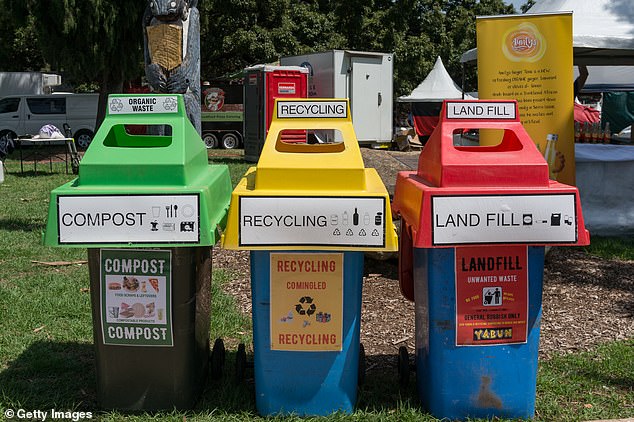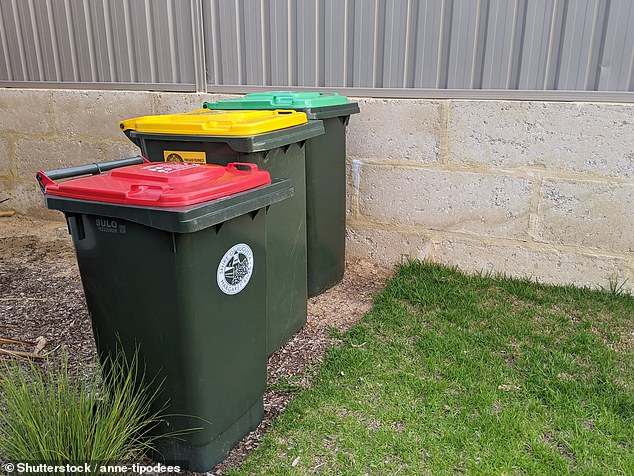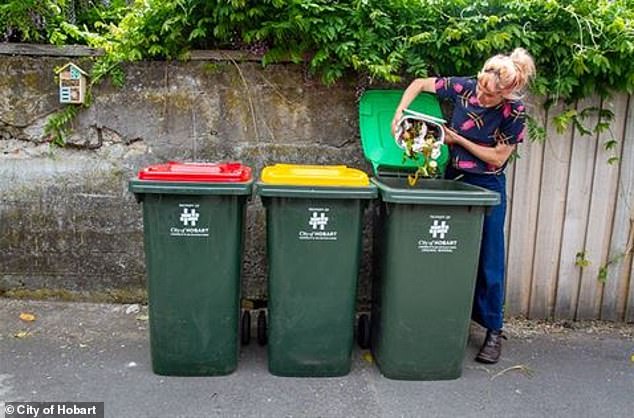All Australian households to get a new bin
>
Households across Australia will receive another bin in a bid to further separate the different forms of waste.
Known as FOGO (Food Organics Garden Organics), the green bin can be reserved strictly for organic garden products, or it can also allow organic food that is then composted, depending on which part of the country you live in.
Unlike your average compost bin, all foods can be placed in the green lid bins, including meat and bones.
The new container is in addition to the common red and yellow containers in Australia, which are for household waste and glass bottles, respectively.
The federal government has committed to providing every household with a FOGO container by 2023, but implementation has so far been slow, with responsibility left to local councils.
For most NSW municipalities, food waste can only be placed in the red lid bins that are sent to landfill.
Randwick Council in Sydney’s east set the tone after introducing FOGO containers in March last year. Residents successfully diverted 1,400 tons of food and organic waste from going to the landfill.
Some residents in Victoria have four bins for their waste, and the latest addition is the purple top (right) for food and organic garden produce.

In South Australia, residents have three bins: the red top is for waste, the yellow is for recycling, and the green is for organics (pictured).

NSW generally separates its rubbish into compost (left), recycling and landfill (right)
Below is a breakdown of how rubbish bins are currently allocated to each state and territory in Australia.
New south Wales
Most households have a general trash bin (red lid), a recycling bin (yellow lid), and a yard green bin (green lid).
In municipalities like the Inner West, where some households have four bins (a red landfill bin, a yellow recycling bin, a green yard waste bin, and a purple food waste bin), the waste bin will be removed. purple and the green dumpster will become a dumpster. FOGO bin.
Victory
In addition to general rubbish, recycling, and FOGO bins, many Victorian homes also have a purple glass fourth bin. The first Australian state to do so, the new containers have been rolled out across 13 local councils and will be expanded to include all Victorian households by 2030.
queensland
Residents have the opportunity to divide their containers into general waste, recycling, and yard waste.
The Sunshine State is currently conducting a 12-month trial of FOGO containers at three councils: Townsville City Council, Rockhampton Regional Council, and Lockyer Valley Regional Council.
south australian
South Australia operates under a three-bin system, with a red bin for general waste, a yellow bin for recyclables, and a green FOGO bin for items such as food scraps, paper towels, tissues and yard waste.
tasmania
They have successfully implemented FOGO bins alongside the standard household trash bin that has a red, dark green or black lid, and a classic yellow-lid bin for recyclables.
ACT
Most households in the nation’s capital are provided with a standard 140-litre red-lidded rubbish bin and a 240-litre yellow-lidded recycling bin. Households can also request another 240-liter green bin for organic garden produce for a one-time registration fee of $50. These bins are used to dispose of plant materials such as weeds, flowers, small branches, leaves, and twigs.

Western Australian residents have three bin systems to choose from, with many opting for red (waste), yellow (recyclables) and green (plant materials); a fourth container is pending for many exclusively for organic waste.

Tasmanian locals also use three bins to separate their rubbish, and have recently adopted FOGO bins.
western australia
Typically, WA households have three container systems to choose from.
The two-bin system has residents allocate a yellow bin for recyclables and a red bin for general waste.
Alternatively, the three-bin Garden Organics (GO) system sees residents receive an additional green-lidded bin for plant materials, in addition to the standard red and yellow bins.
Locals in the West can also choose a three-container Organic, Garden Organic (FOGO) food system. The main difference is the The green bin can also process food scraps and paper products.
Northern Territory
The Top End operates using the two container model. Residents can divide their waste into two containers: a red-lidded container for general waste and a yellow-lidded container for recycling.
